|
Night Flying - Humberside (EGNJ)
Wednesday 17th December, 2008
As I set off for a meeting in Commercial Street just before 11.00,
there were clear blue skies aloft and the weather was
looking good for the night flight planned that evening.
En route I received a text from Brian reminding me to take my
camera. I replied that it was already charged up and packed!
Later that afternoon the drive over to Sherburn was
fortunately uneventful
so I met up with Brian on time in the club house. He
was already sorting out the paper
work and checking the NOTAMs. The intention was to track east
out to OTR and then south to Humberside. When Darren arrived
we discussed the wind forecast and noted we'd have
a strong tail wind out to OTR and a strong headwind on the
way back. As
the plane was already available we decided not to waste
any time and set off.
While Darren contacted Humberside ATC and booked in Oscar Hotel,
Brian and I went out to do the external checks which, by torchlight,
was quite challenging!
It was freezing cold so it was good to get inside the plane
but the engine needed several primes before it could be started.
After doing the power checks and de-misting the windows we took
off from 29 departing east for Selby from the downwind leg.
As Brian contacted
Humberside we flew past Drax which was spewing a
fog of steam into the night sky against an eerie back
drop of white and red lights.
By this time Darren had figured out that the HSI wasn't working
correctly and so we had to let Humberside know we'd be doing a
visual landing instead of the ILS one already booked in.
We were provided with a Flight Information
Service, instructed to squawk 4270, use the Barnsley QNH 1010 and report
at Elsham Wolds VRP. The runway in use was 21. As we tracked towards
the Humber Bridge north of Goole, Scunthorpe sparkled to the south
and Hull to the north. Beyond was a vast and empty dark space:
the North Sea.
At Trent Falls we turned onto a southerly heading and tracked towards
Elsham Wolds. On being handed over to Tower we were asked
to join on the downwind leg for 21 and report final and advised the
wind was 190°/10 knots. It proved very
difficult to see the runway from the north at such a low altitude
despite there being lights
all the way around it. Finally Darren spotted the green lights at the
threshold enabling him to gauge where he was relative to the end of
the runway. As we turned onto base the full runway came into view -
a vista of orange, red and green lights spread out before us. The runway
perspective was perfect and Darren used the PAPI lights to keep
him on the correct glide slope. Within a few minutes we were down on
the ground. My brain reeled - would I ever be able to achieve that
myself one day!
As Darren completed the shutdown checks, we heard the KLM (a Fokker 70)
being given taxi clearance and watched it start being pushed back. Shortly after
we exited Oscar Hotel and Brian pondered whether we going to experience
jet wash at such close quarters!
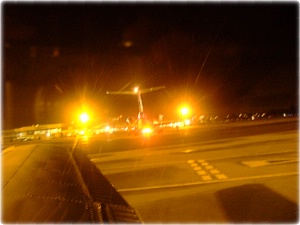
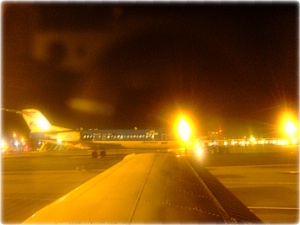
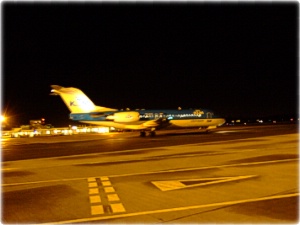
We went into the airport, completed the paper work at the
information desk and paid the landing fee. Unfortunately
the cafe was closed so Darren booked the
plane out again and we went straight back to the reporting point (C)
hut and cleared security there.
While Brian started the internal checks, Darren listened to the ATIS:
QNH 1013, Information Charlie, 17:53, runway in use 21, wind 210°/12,
visibility 10 kilometres or more, FEW 3,000 feet, temperature 5°C,
dew point 3°C. Then he contacted tower: 'Humberside Tower, Golf Bravo
November Oscar Hotel on the southern apron with Information Charlie,
request engine start'. 'QNH 1013, squawk 4261, engine
start approved'.
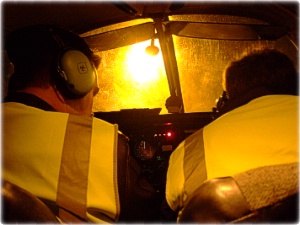
On advising Humberside we were ready to taxi, we were
instructed to hold position until a helicopter had passed down our right
hand side. We were then cleared to taxi to the Alpha holding point,
the lights for which could be seen in the distance. At the hold
Brian positioned the plane as far into wind as he could for the
power checks. He set two stages of flap for takeoff and reported
ready for departure. Tower instructed us to 'line up and wait 21'.
Finally Tower came back to us: 'Left turn out, cleared for take-off'.
As Brian climbed to 1,300 feet we were asked to contact Humberside
Radar who provided us with a FIS.
A few moments later Humberside advised there was a helicopter
(a Dauphin) to the east of the Humber Bridge tracking towards us at a similar level
but we would be climbing above it. The helicopter immediately reported
they were visual with us (the Cherokee), while we scanned the sky. Seconds later
we were able to detect a moving white light and reported visual as well.
As we flew north Darren pointed out the North Sea gas rigs and
eventually we came to the mouth of the Humber. At this point he
set up the VOR to track from OTR on the 280° radial back to Sherburn
and noted (due to the wind) our ground speed was only 66 knots. It was
going to take some time to get home to Sherburn! As we flew down the Humber we
could see lots of sports grounds lit up and even some Christmas lights.
Eventually we came to the Humber Bridge.
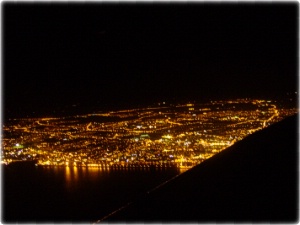
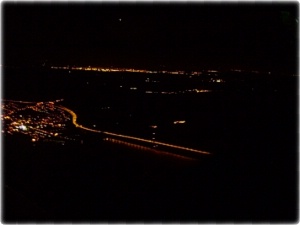
En route we noticed what we thought was possibly another helicopter -
a very bright light towards the south west. However it didn't move
relative to us so we figured it must have been be a star
(most probably Venus I discovered later).
As we passed Goole to the south of us we looked out for Drax,
but couldn't see it immediately possibly because of steam obscuring its view.
Once on the home strait we requested a radio frequency change to Sherburn and
discovered the runway in use was now 11. Darren and Brian debated
whether or not to request a join on the
downwind leg (by this time the wind was becoming somewhat turbulent) and
asked Mike if there were any other aircraft in the circuit.
Mike obliged and put out a call to find out. There was no response.
'I think that's your answer' he advised. So we elected to join
downwind at 1,000 feet.
Again on the downwind leg the runway was not as easy to see. After
a wind check (170°\10 knots) Brian prepared himself for a cross wind
landing. As he flew around Steeton Hall onto the base leg it became
evident the crosswind was stronger than anticipated and accompanied
by a stiff gusting wind. As an added precaution for the landing Brian
asked Darren to follow him through on the controls just in case he should
judge anything incorrectly near the ground.
The base leg was extended slightly due to the tail wind and Brian crabbed
towards Sherburn in Elmet on the turn for final at which point, once again,
the full vista of runway lights suddenly became visible. He decided to
stay with two stages of flap (i.e. not use the drag flap) to ensure a more
stable approach and descended on a 4° glide path using the Abbreviated PAPI
to make sure we cleared the pylons only metres behind the threshold. A
small amount of power was required at 300 feet as the white APAPI light
was slowly changing to a pinkish hue indicating we were getting slightly
low. As Brian flared near the ground, Darren added right rudder to straighten
up a fraction of a second ahead of Brian which he indicated later as having
simply been a reflex action! At two stages of flap the aircraft floated and
once lined up with the runway, Darren advised 'just put it down'. Brian
acknowledged this had been the right call to make - with no headwind component
they had to make sure they did not run out of runway on the landing roll. On
touch-down they applied brakes, brought the plane to a walking pace and used
the second exit from the runway.
As we taxied to the pumps we looked back at the windsock - it was
horizontal so there had been a crosswind of around 15 knots. Again my
head reeled. How much harder could a landing get (at night with a full
crosswind on 11)? For me Darren and Brian had demonstrated excellent
team work and airmanship in very challenging conditions.
|